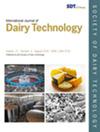The impact of oil source on the foaming properties of model infant formula emulsions
Abstract
Background
Foam is an undesirable occurrence during the manufacture of nutritional oil-in-water emulsion food products, such as infant formula, and also during the consumer experience of preparing nutritional formulas. Understanding the causes of foam formation can help to develop appropriate mitigation strategies for satisfactory manufacturing and consumer experiences.
Aim
This study investigated the impact of commonly used oil sources on the foaming properties of model infant formula emulsions.
Methods
The oils studied were soybean oil, 1, 3-dioleoyl-2-palmitoylglycerol (OPO)-rich palm oil, coconut oil, anhydrous milk fat (AMF), sunflower oil and an oil mix (blend of oils typically used in infant formulas). The model infant formula emulsions contained equivalent macronutrient content and underwent equivalent processing operations during preparation. Foam properties assessed included foamability, foam capacity, stability and structure.
Major findings
The oil mix and OPO-rich palm oil significantly inhibited foaming, or destabilised foam, followed by AMF, whereas the other oils had no effect. The foam height immediately after sparging in formulas containing the oil mix and OPO-rich palm oil was 30 and 80 mm, respectively, with collapse after just 38 and 60 s. Contrastingly, the other formulas produced foam heights of 130–140 mm. Although the formula containing AMF showed a gradual reduction in foam over time, the remaining formulas maintained stable foam throughout the 20-min measurement. No relationship was determined between fat globule size or viscosity and foaming. The inhibitory effect of oils may be multifactorial, that is fatty acid profile, including palmitic acid content and triglyceride structuration, the presence of low molecular weight components, fat physical state and melting points, and the competitive interactions between different oils in the mix.
Implications
This study provides insight into the impact of oil source on foam properties of model infant formula emulsions and guides further research on mechanistic reasons behind the findings.


 求助内容:
求助内容: 应助结果提醒方式:
应助结果提醒方式:


